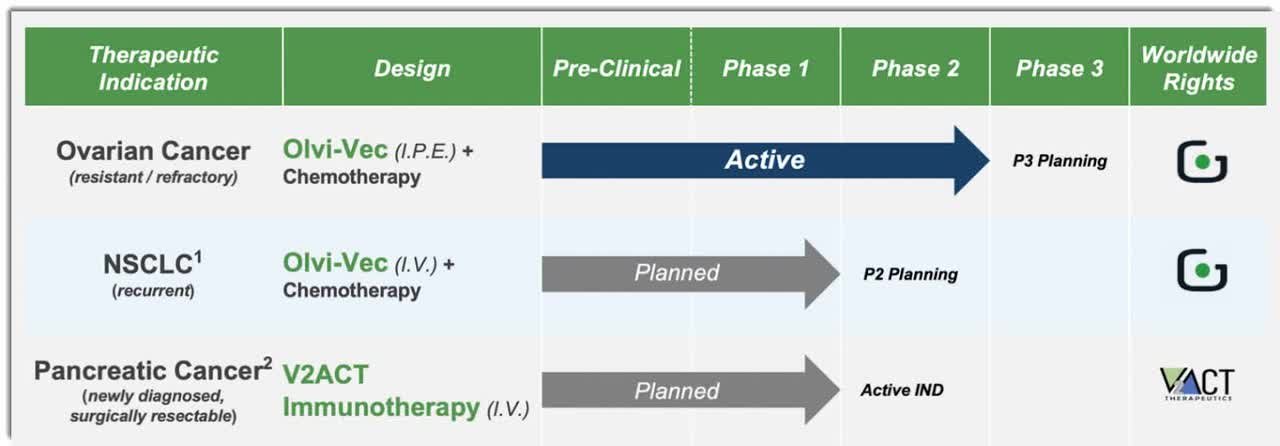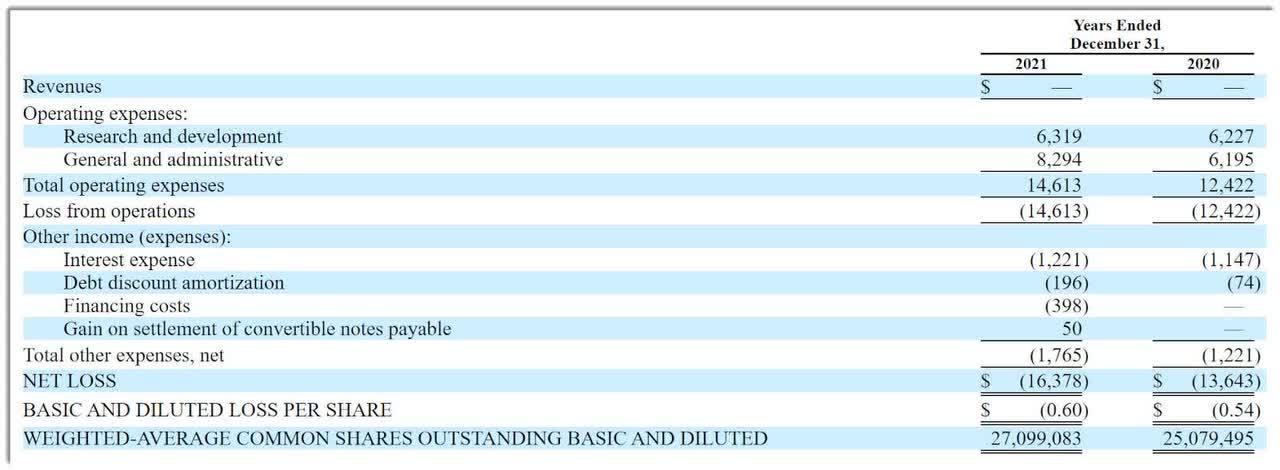Morsa Images
What Is Genelux?
Westlake Village, California-based Genelux (GNLX) was founded to develop treatments for various aggressive or difficult-to-treat solid tumor cancers.
Management is headed by president and CEO Thomas Zindrick, J.D., who has been with the firm since May 2014 and was previously CEO of Amitech Therapeutics Solutions and held the position of Vice President Associate General Counsel at Amgen.
The firm’s lead candidate is Olvi-Vec, which is in Phase 3 planning phase for the treatment of platinum resistant/refractory ovarian cancer [PRROC] and which has already met a preliminary endpoint for its Phase 2 trial for that disease.
Below is the current status of the company’s drug development pipeline:
Company Pipeline (SEC EDGAR)
Genelux has booked fair market value investment of $168.9 million in equity and convertible debt as of June 30, 2022 from investors.
Genelux’ Market & Competition
According to a 2018 market research report by bcc Research, the global market for ovarian cancer therapeutics was an estimated $2.1 billion in 2017 and is forecast to reach $2.9 billion by 2022.
This represents a forecast CAGR (Compound Annual Growth Rate) of CAGR of 7.1% from 2017 to 2022.
Key elements driving this expected growth are a growing incidence of cancers as global populations age and immune system performance is reduced.
Also, new drug classes are expected to be approved, with five new drugs expected to be approved by 2028.
However, the growth in use of biosimilar products and generics will likely act as a drag on growth of the market’s total dollar value over time.
Notably, the GlobalData estimate for the ovarian cancer market has a much higher estimate, with the market forecast to reach $6.7 billion by 2028.
Major competitive vendors that provide or are developing related treatments include:
-
Amgen
-
AstraZeneca
-
Boehringer Ingelheim
-
CG Oncology
-
Candel Therapeutics
-
Daiichi Sankyo
-
DNAtrix
-
Johnson & Johnson
-
Merck
-
Oncolytics Biotech
-
Oncorus
-
Replimmune
-
SillaJen
-
Targovax USA
-
Transgene SA
-
Others
Genelux’ IPO Date & Details
The initial public offering date, or IPO, for Genelux is still to be determined by the company.
(Warning: Compared to stocks with more history, IPOs typically have less information for investors to review and analyze. For this reason, investors should use caution when thinking about investing in an IPO, or immediately post-IPO. Also, investors should keep in mind that many IPOs are heavily marketed, past company performance is not a guarantee of future results and potential risks may be understated.)
GNLX intends to sell 2.5 million shares of common stock at a proposed midpoint price of $6.50 per share for gross proceeds of approximately $16.25 million, not including the sale of customary underwriter options.
No existing or potentially new shareholders have indicated an interest to purchase shares at the IPO price.
Assuming a successful IPO at the midpoint of the proposed price range, the company’s enterprise value at IPO (excluding underwriter options) would approximate $135.5 million.
The float to outstanding shares ratio (excluding underwriter options) will be approximately 10.6%. A figure under 10% is generally considered a ‘low float’ stock which can be subject to significant price volatility.
Per the firm’s most recent regulatory filing, it plans to use the net proceeds as follows:
approximately $7.7 million to fund the clinical development of our lead product candidate, Olvi-Vec, in PRROC;
approximately $1.0 million to pay outstanding accounts payable; and
any remaining proceeds for working capital and general corporate purposes.
(Source – SEC)
Management’s presentation of the company roadshow is not available.
Regarding outstanding legal proceedings, management says the firm is not currently a party or received notice of any material legal proceedings against it.
Listed underwriters of the IPO are The Benchmark Company and Brookline Capital Markets.
How To Invest In The Company’s Stock: 7 Steps
Investors can buy shares of GNLX stock in the same way they may buy stocks of other publicly traded companies or as part of a pre-IPO allocation.
Note: This report is not a recommendation to purchase GNLX stock or any other security. For investors who are interested in pursuing a potential investment after the GNLX IPO is complete, the following steps for buying stocks will be helpful.
Step 1: Understand The Company’s Financial History
Although there is not much public financial information available about the company, investors can look at the company’s financial history on their form S-1 or F-1 SEC filing (Source).
Step 2: Assess The Company’s Financial Reports
The primary financial statements available for publicly-traded companies include the income statement, balance sheet, and statement of cash flows. These financial statements can help investors learn about a company’s cash capitalization structure, cash flow trends and financial position.
The firm’s recent financial results are typical of a clinical stage biopharma in that they feature no revenue and significant R&D and G&A expenses associated with advancing its pipeline.
Below are the company’s financial results for the past two calendar years:
Statement Of Operations (SEC EDGAR)
As of June 30, 2022, the company had $4.2 million in cash and $48.2 million in total liabilities.
Step 3: Evaluate The Company’s Potential Compared To Your Investment Horizon
When investors evaluate potential stocks to buy, it’s important to consider their time horizon and risk tolerance before buying shares. For example, a swing-trader may be interested in short-term growth potential, whereas a long-term investor may prioritize strong financials ahead of short-term price movements.
Step 4: Select A Brokerage
Investors who do not already have a trading account will begin with the selection of a brokerage firm. The account types commonly used for trading stocks include a standard brokerage account or a retirement account like an IRA.
Investors who prefer advice for a fee can open a trading account with a full-service broker or an independent investment advisor and those who want to manage their portfolio for a reduced cost may choose a discount brokerage company.
Step 5: Choose An Investment Size And Strategy
Investors who have decided to buy shares of company stock should consider how many shares to purchase and what investment strategy to adopt for their new position. The investment strategy will guide an investors’ holding period and exit strategy.
Many investors choose to buy and hold stocks for lengthy periods. Examples of basic investing strategies include swing trading, short-term trading or investing over a long-term holding period.
For investors wishing to gain an allocation of shares at the IPO price, they would ‘indicate interest’ with their broker in advance of the IPO. Indicating an interest is not a guarantee that the investor will receive a pre-IPO allocation of shares.
Step 6: Choose An Order Type
Investors have many choices for placing orders to purchase stocks, including market orders, limit orders and stop orders.
-
Market order: This is the most common type of order made by retail traders. A market order executes a trade immediately at the best available transaction price.
-
Limit order: When an investor places a buy limit order, they specify a maximum price to be paid for the shares.
-
Stop order: A buy-stop order is an order to buy at a specified price, known as the stop price, which will be higher than the current market price. In the case of buy-stop, the stop price will be lower than the current market price.
Step 7: Submit The Trade
After investors have funded their account with cash, they may decide an investment size and order type, then submit the trade to place an order. If the trade is a market order, it will be filled immediately at the best available market price.
However, if investors submit a limit order or stop order, the investor may have to wait until the stock reaches their target price or stop-loss price for the trade to be completed.
Commentary About Genelux
GNLX is seeking U.S. public capital market investment to fund further advancement of its pipeline of treatments through mid and late stage trials.
The firm’s lead candidate, Olvi-Vec, which is in Phase 3 planning phase for the treatment of platinum resistant/refractory ovarian cancer [PRROC] and which has already met a preliminary endpoint for its Phase 2 trial for that disease.
The market opportunity for ovarian cancer treatments is reasonably large and expected to grow at a moderate rate of growth over the coming years.
Management hasn’t disclosed any major pharma firm collaboration relationship.
The company’s investor syndicate does not include any widely known institutional life science investors or strategic investors.
The Benchmark Company is the lead underwriter and the four IPOs led by the firm over the last 12-month period have generated an average return of 85.5% since their IPO. This is a top-tier performance for all major underwriters during the period.
Genelux has achieved a milestone that many biopharma firms at IPO have not, that of achieving a Phase 2 efficacy endpoint, so in that regard the IPO is somewhat unusual, in a positive way.
As for valuation, management is asking investors to pay an Enterprise Value of around $136 million at IPO. This is well below the typical range for a biopharma firm at IPO.
While the company will likely need additional funding for future trial activities, for life science investors with a patient hold time frame, given the firm’s positive Phase 2 trial results to-date, my outlook on the IPO is a Buy at up to $6.50 per share.


Be the first to comment